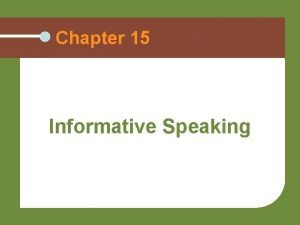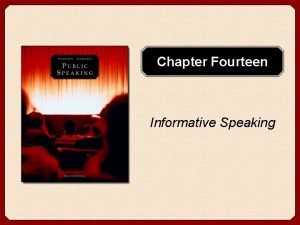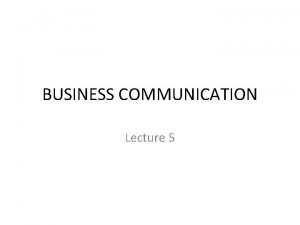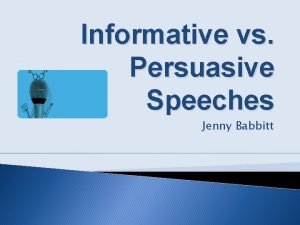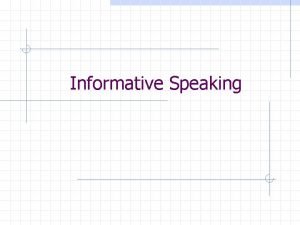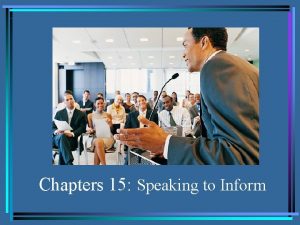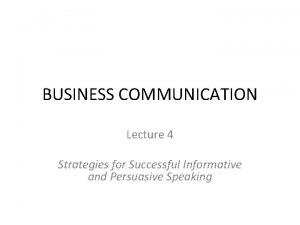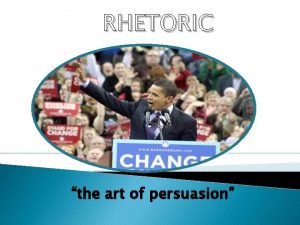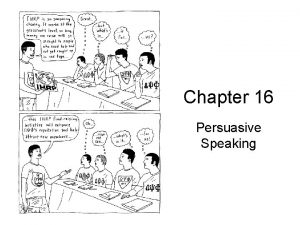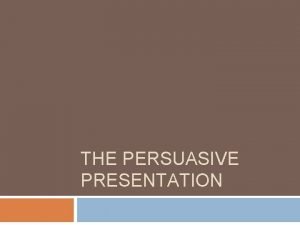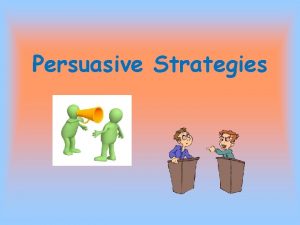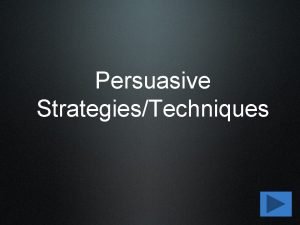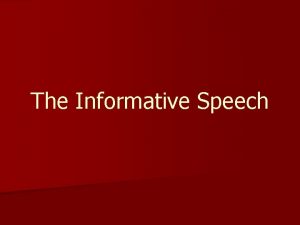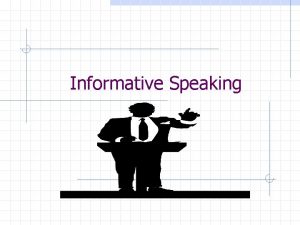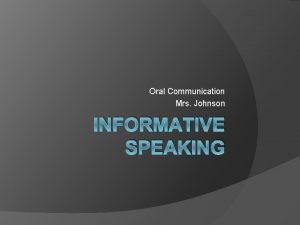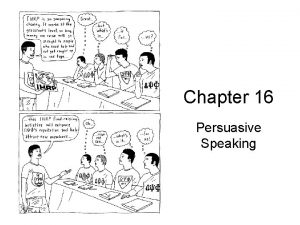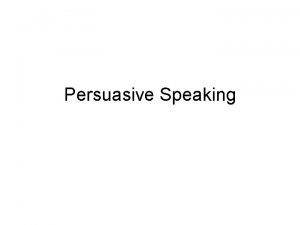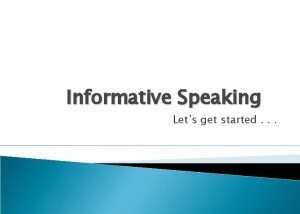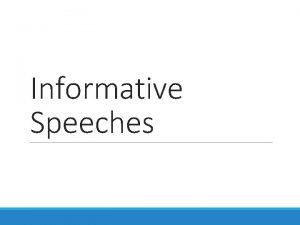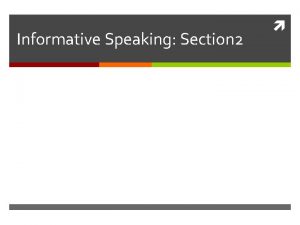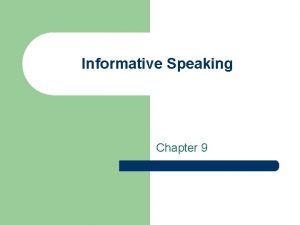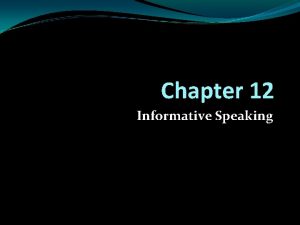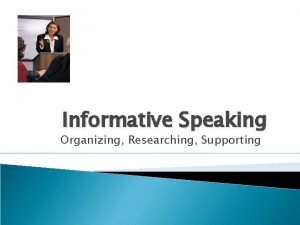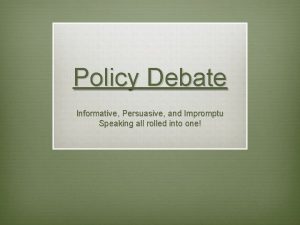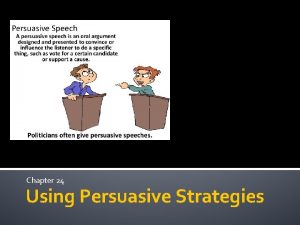1 Strategies for Successful Informative and Persuasive Speaking












































- Slides: 44

1

Strategies for Successful Informative and Persuasive Speaking. Chapter No. 15 By: Saif Bukhari 2

Strategies for Successful Informative and Persuasive Speaking. I. Purposes of Informative and Persuasive Speaking A. Informative Specific Purposes B. Persuasive Specific Purposes II. Kinds of Informative and Persuasive Speaking A. Informative Speaking, B. Persuasive Speaking 3

Strategies for Successful Informative and Persuasive Speaking III. Audience Analysis for Informative and Persuasive Speaking A. Degrees of Interest and Attitudes B. Occasion C. Location IV. Organization for Informative and Persuasive Speaking A. The Introduction B. The Body (Text. Discussion) C. The Summary or Conclusion V. Supports for Informative and Persuasive Speaking A. Six Forms of Support (Evidence. Data) B. Questions on Forms of Support 4

5

Purposes of Informative & Persuasive Speaking Kinds of Informative & Persuasive Speaking Audience Analysis for Informative and Persuasive Speaking Organization for Informative & Persuasive Speaking Supports for Informative & Persuasive Speaking 6

Speaking n n n The action of conveying information or expressing one’s feelings in speech: clear thinking aids clear speaking The activity of delivering speeches: Public speaking n Public speaking is the process of speaking to a group of people in a structured, *deliberate manner intended to inform, influence, or entertain the listeners. *Purposeful 7

Communication n Communication is the transmission of messages from a Sender (a person or group) to a Receiver (another person or group). In a perfect world, the receiver would understand. n The message without difficulty. But too often, that doesn’t happen. A lack of clarity, poor Choice of words, distractions, and a host of other obstacles can interfere with the message. 8

Strategies n n A careful plan or method for achieving a particular goal usually over a long period of time. Strategies ▪ The skill of making or carrying out plans to achieve a goal. ▪ A specialist in campaign/military strategy 9

Strategies n n n Examples of STRATEGY They are proposing a new strategy for treating the disease with a combination of medications. The government is developing innovative strategies to help people without insurance get medical care. 10

Informative Speaking n n Informative speaking is a speech that primarily aims at conveying some specific information to a person or a group of persons. However, it being an oral activity, it is similar to an oral presentation in its mode and purpose. 11

PURPOSE OF INFORMATIVE SPEAKING n n General purposes of oral communications vary with the situations, kinds of talks and the audience. Purpose of informative speaking maybe: n n To To convey information to an audience discuss and analyze a problem persuade and prepare an audience for a specific purpose entertain an audience 12

PURPOSE OF INFORMATIVE SPEAKING n n n Main objective of informative speaking is of course to present ideas clearly and promote understanding for listeners, either inside or outside the organization, as the situation maybe. This objective cannot be realized without deciding upon the specific purpose of the speech. Purpose of a speech is two fold, i. e. n To give information to the audience n To persuade the audience to some desired action 13

PURPOSE OF INFORMATIVE SPEAKING n n If the general purpose of informative speaking is simply to give information to an audience, then the specific purpose is certainly the precise, exact result the speaker hopes to achieve with his listeners. With this specific purpose in mind, the speaker should consider about the subject of his speech. The subject may be: n A Process n A Policy 14

PURPOSE OF INFORMATIVE SPEAKING n n n Whether it is the Process as purpose or Policy as purpose, the speaker is required to take into account the essential steps meant for successful speaking, and follow them in a systematic order to achieve the desired result with his listeners In both cases the speaker may use visual aids to ensure that the speech serves its specific purpose of communicating information effectively. The essential steps that the speaker should consider for effective informative speaking are about the same that are required to make effective oral presentations 15

PURPOSE OF INFORMATIVE SPEAKING n The steps include: n n n Determining the purpose of speech Analyzing the audience and the situation Choosing main ideas of the speech Researching the topic Organizing the data and making an outline Doing a rehearsal of the speech 16

KINDS OF INFORMATIVE SPEAKING AND ORAL PRESENTATIONS n Kinds of informative speaking and oral presentations vary depending on the nature of the subjects under discussion. However, we may broadly classify them as: n n 1. Short Talks 2. Long Speeches 17

SHORT TALKS n Short talks range from 1 to 10 minutes in length. They may be made to serve any required purpose. The purpose may be to exchange a brief information, n To welcome visitors and agents, n To say a few words at some function, or n To present brief progress reports, etc. 18

LONG SPEECHES n n n Compared with short talks, long speeches are rather formal in their mode, and so they may be called formal presentations. Long speeches usually range from 10 minutes to 1 hour. Like short talks, subjects of long speeches also vary. They may comprise informative reports on different subjects or such speeches and presentations as maybe made on different occasions to enhance the image and working of the business house. 19

LONG SPEECHES n Taking into view the nature of the speeches made on important events, Long speeches may further be classified as: n n 1. 2. 3. 4. General Reports Community Goodwill Speeches Briefings Instructions 20

ORGANIZATION AND OUTLINE OF INFORMATIVE SPEECH n ORGANIZATION OF SPEECH n Making speeches is as important as writing of messages. Sometimes business people must make formal presentations. Sometimes they have to talk to their colleagues and professionals. Sometimes they have to conduct and participate in committee meetings, conferences and group discussions. 21

ORGANIZATION AND OUTLINE OF INFORMATIVE SPEECH n ORGANIZATION OF SPEECH n Making a formal speech is a difficult task for most people. Generally people feel somewhat uncomfortable while speaking before others. It is, therefore, important for business people that they learn speaking techniques 22

ORGANIZATION AND OUTLINE OF INFORMATIVE SPEECH n ORGANIZATION OF SPEECH It is desirable that the person who is to deliver a formal speech takes the following steps in advance, i. e. he: n Determines the purpose of speech n Analyzes the audience and the situation n Chooses main ideas of the speech n Researches the topic n Organizes the data and makes an outline n Makes arrangements for audio-visual aids, if required. n Does a rehearsal of the speech 23

ORGANIZATION OF SPEECH IN PARTS n n Once the speaker has done his preparatory work and has gathered all the information that he needs, he should begin organizing the speech. A good formal speech is organized in the following three parts: n n n Introduction The Body (Text) The Close (Conclusion) 24

OUTLINE OF SPEECH n Outline of a speech means its sketch or synopsis. It is an essential requirement for a speaker, particularly in long informative speaking. n n n A good outline should include the following: 1. Title 2. Purpose 3. Introduction 4. Text 5. Summary Finally, it is advisable that the speaker should draw the outline of the main sections. 25

Persuasive Speaking n n A persuasive speech is one that establishes a fact, changes a belief, or moves an audience to act on a policy. A persuasive speech that establishes a fact proves that something is true or false. 26

n I. Purposes of Information and Persuasive Speaking n n A. Informative Specific Purposes B. Persuasive Speaking 27

28

Purposes of Informative Speaking n n Making an idea clear is central to the purpose of informative speaking Suggestions: n The purpose should be specific n n n To compare information, using the criterion of modern technology, as to which country should host the year 2012 Olympic Games The title of your speech and purpose should be linked The purpose could be process, policy, any incident, etc 29

Purposes of Persuasive Speaking n n Gaining willingness / acceptance of your central idea is the core purpose of persuasive speaking Suggestions: n The purpose should be specific n n n To suggest that Taiwan’s capital investments in China were greater than in other sections of the world You should be thoughtful and have given ample time in preparing your speech Plan in advance your desired response your speech should lead towards the desired response The purpose could be process, policy, any incident, etc 30

Reports Good Will Briefings Instruction • Periodic department reports • Progress reports on sales or ongoing committee activities • Statements on area or division responsibilities • Reports on manufacturing problems in the plant • Reports on Competitive Operations • Reports on problems with vendors (dealer) • Monthly personnel reports • Abstract of contact reports for months • Companies often arrange public speaking or meetings for good will creation • Short problem solving sessions • How to do, what to do 31

32

AUDIENCE ANALYSIS n For a non-familiar audience find out the following 1. 2. 3. Their interests, disinterests and attitudes The occasion The location of your speech 33

1. Degrees of Interest & Attitudes 34

1. Degrees of Interest & Attitudes Search for Common Ground • Begin with a familiar, commonly accepted topic • Use visuals, examples, goodwill comments • Clearly keep in account the culture of countries • Use the following four approaches • Insert praise for the organization and its members • Mention names of colleagues or friends within the organization with whom you have worked in the past • Make use of patriotism, loyalty and cooperation • Be polite – even poke fun at yourself Compare Agreements and Disagreements • Before giving speech, review areas of agreements and disagreement • Depend upon facts, use value judgments very carefully • You may draw parallel columns • Find out in advance what you may face in front of a hostile audience to deal with them nicely 35

Offer a greeting to gain Good Will Make use of the fairness concept • “we have differences in philosophy, yet I bring you greetings from many friends of yours home I have met during this past year” • ‘All of us in this room have a degree of freedom not experienced anywhere else in the world; I am using that freedom to bring a different point of view” Appeal to a sense of human weaknesses • “well, I have made mistakes in my days; may I tell you about one made in my first appearance before this group” Quote from a supporter of the audience’s views • “one of the directors of your association strongly supported the concept of brotherhood. I will begin with a quotation he uttered last year” 36

2. Occasion If you are speaking in familiar work settings; you already know the people, their position and their attitudes Inside Company If you are speaking outside your group, devote more thought to the occasion Find out: if you are the main speaker; are you the first or last in the program, how long will you speak? Additionally for outside groups if there is higher variation or less possible prediction, then it’s a must to find out about other party’s position and interest in addition to research on your position Outside Company 37

3. Location n Find out in advance; what is the physical environment of your presentation as it may be any of the following and all have their own psychological influences n n n An open environment Large auditorium Conference room (small or big) Any lounge etc Find out whether you have a podium or a table Check whether you have all your requirements fulfilled; charts, markers, multimedia, projector etc 38

ORGANIZATION OF YOUR SPEECH The introduction The porch Tell a related story or joke Use a quotation that gives background or inspiration to your speech Greet your audience Make a startling statement Ask thought provoking statements The Aim The Layout Make clear and precise statement of the purpose of your speech This is the overview, roadmap or agenda of your speech / 39 presentation

ORGANIZATION OF YOUR SPEECH The body (Text, Discussion) The Summary (Conclusion) Persuasive Speaking; this section should contain the clear idea followed by credible supporting material Summaries reiterate what was covered; conclusions are inferences from data Informative Speaking; the body or discussion of your topic is where your ideas are developed in detail Problem Solution (For change); problemsolution-benefits. You may also mention the disadvantages if your recommendation is not accepted Problem solution (for no change) you use the above approach; while mentioning that no problem exists 40

UPPORTS FOR INFORMATIVE AN PERSUASIVE SPEAKING WHY SUPPORT Your speech should give the feeling that you know your topic, that your are fair, honest and believable You may use emotions to support your idea like health, fear, self-esteem, etc You must use evidence and reasoning USE ANY NUMBER Examples, Illustrations, Statistics, Quotations (testimony), Comparisons (Analogies), Definitions OF SUPPORT FORMS THAT MAY etc HELP YOUR PRESENTATION 41

Forms of Support (Evidence, Data) • Very commonly used, self explanatory Examples Illustrations Statistics • Illustrations are elongated examples; they layout in detail a specific situation; in which the solution worked • Find out which statistical measure to use to prove the validity of the data Quotations, Testimony • Quoting credible sources also improves the speaker’s credibility Comparisons (analogies) • Comparisons demand similarities between two subjects; those similarities should outweigh the dissimilarities Definitions • Definitions not exactly support, yet using them helps both speaker and audience to be at the same level of understanding 42

43

n Thanks 44
 Informative and persuasive venn diagram
Informative and persuasive venn diagram Youtu.bev
Youtu.bev Uil informative speaking
Uil informative speaking Characteristics of effective informative speaking
Characteristics of effective informative speaking Goals of informative speaking
Goals of informative speaking What is the essence of informative speaking
What is the essence of informative speaking Strategies for successful interpersonal communication
Strategies for successful interpersonal communication Successful job search strategies
Successful job search strategies Informative vs persuasive
Informative vs persuasive Persuasive speech vs informative speech
Persuasive speech vs informative speech Instructive text structure
Instructive text structure Informative speech vs persuasive speech
Informative speech vs persuasive speech Informative speech strategies
Informative speech strategies Informative communication strategies
Informative communication strategies Rhetoric: the art of persuasive writing and public speaking
Rhetoric: the art of persuasive writing and public speaking Art of speaking and writing
Art of speaking and writing Value persuasive speech
Value persuasive speech Presentation explain
Presentation explain Definition of persuasive speech
Definition of persuasive speech Persuasion appeals to
Persuasion appeals to Big names examples persuasive
Big names examples persuasive Big names persuasive strategies examples
Big names persuasive strategies examples Counter claims examples
Counter claims examples Persuasive writing strategies
Persuasive writing strategies Kontinuitetshantering
Kontinuitetshantering Typiska drag för en novell
Typiska drag för en novell Tack för att ni lyssnade bild
Tack för att ni lyssnade bild Vad står k.r.å.k.a.n för
Vad står k.r.å.k.a.n för Shingelfrisyren
Shingelfrisyren En lathund för arbete med kontinuitetshantering
En lathund för arbete med kontinuitetshantering Personalliggare bygg undantag
Personalliggare bygg undantag Personlig tidbok
Personlig tidbok Sura för anatom
Sura för anatom Vad är densitet
Vad är densitet Datorkunskap för nybörjare
Datorkunskap för nybörjare Stig kerman
Stig kerman Att skriva en debattartikel
Att skriva en debattartikel Delegerande ledarskap
Delegerande ledarskap Nyckelkompetenser för livslångt lärande
Nyckelkompetenser för livslångt lärande Påbyggnader för flakfordon
Påbyggnader för flakfordon Tryck formel
Tryck formel Svenskt ramverk för digital samverkan
Svenskt ramverk för digital samverkan Jag har nigit för nymånens skära text
Jag har nigit för nymånens skära text Presentera för publik crossboss
Presentera för publik crossboss Vad är ett minoritetsspråk
Vad är ett minoritetsspråk




